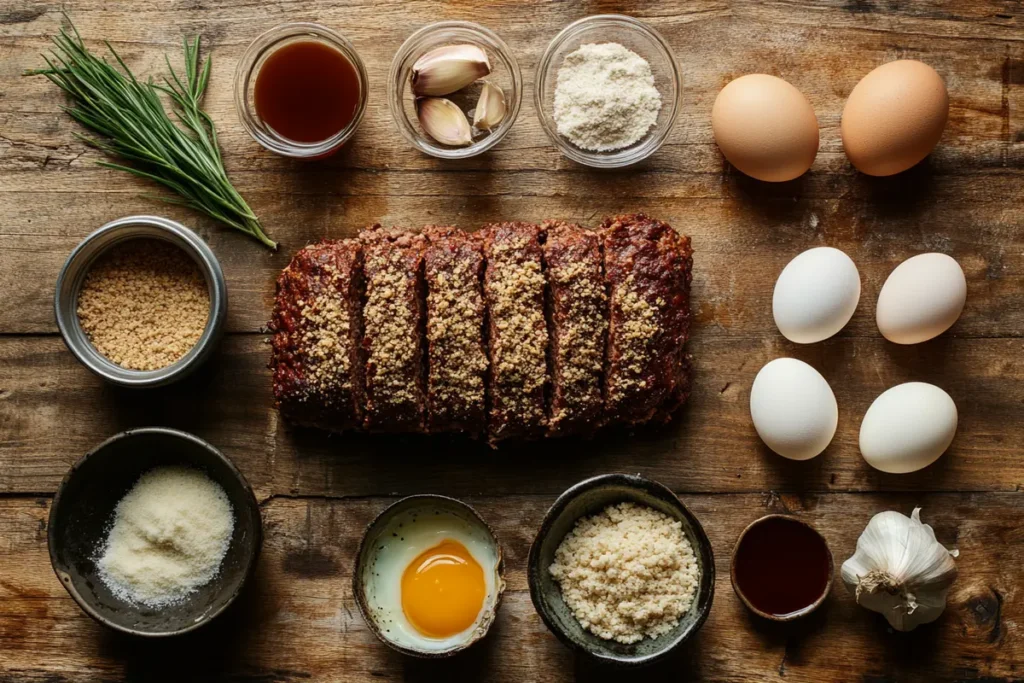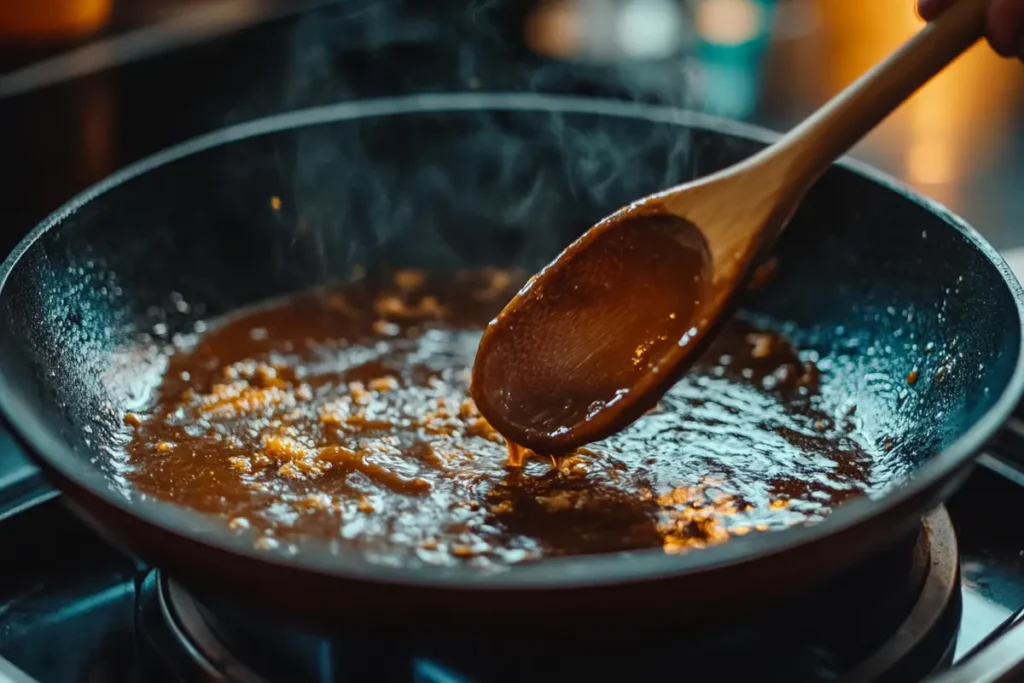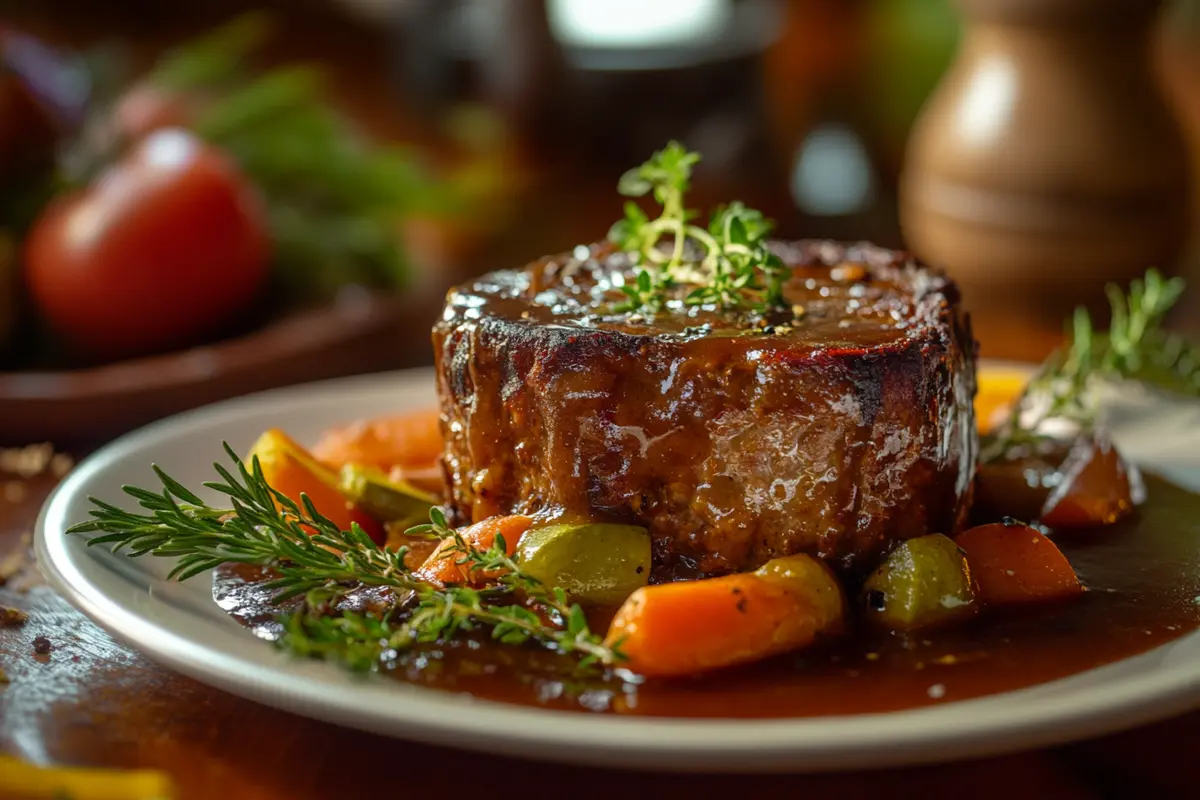Okay, let’s get this article rolling! Here’s the introduction and Part 1, following all the guidelines:
Introduction to Meatloaf with Brown Gravy
Meatloaf with brown gravy is the ultimate comfort food. It’s hearty, flavorful, and perfect for family dinners or special occasions. This article will guide you through the entire process—from gathering the right ingredients to creating a rich brown gravy and baking the perfect loaf. Along the way, we’ll also explore how important is the egg in meatloaf, why it matters, and how to make your meatloaf moist and delicious every time. Let’s dive into the savory world of homemade meatloaf!
Introduction to Meatloaf with Brown Gravy
What Makes Meatloaf with Brown Gravy an All-Time Favorite?
Meatloaf has been a staple in kitchens for decades, and for good reason. It’s budget-friendly, easy to make, and incredibly versatile. Whether you’re serving it for a casual dinner or dressing it up for a holiday spread, this dish always delivers. The combination of ground meat, seasonings, and just the right amount of moisture makes it both satisfying and nostalgic. When making meatloaf, many people wonder how important is the egg in meatloaf. Eggs are the secret ingredient that holds everything together and contributes to the dish’s moist texture.
Why Eggs and Brown Gravy are Essential for Delicious Meatloaf
Adding brown gravy elevates a simple meatloaf to the next level. This luscious topping not only enhances the flavor but also keeps the meatloaf moist. The savory richness of the gravy complements the tender texture of the meat, creating a perfect harmony on your plate. Eggs also play a key role here, as they help the meatloaf hold its shape, making it easier to slice and serve with gravy. Knowing how important is the egg in meatloaf will help you create a dish that’s both flavorful and structurally sound.
Part 2: Key Ingredients for a Delicious Meatloaf Recipe
The Essentials: Ground Beef, Breadcrumbs, and the Role of Eggs in Meatloaf

A traditional meatloaf recipe begins with ground beef, breadcrumbs, and eggs. Ground beef provides the rich, savory base, while breadcrumbs help bind the mixture. Eggs play a crucial role in holding the meatloaf together and keeping it moist. Wondering how important is the egg in meatloaf? It not only binds but also adds a subtle creaminess. You can substitute eggs with alternatives like flaxseed or yogurt if needed.
Tips for Choosing the Best Ingredients for Your Meatloaf Recipe
Choosing the right meat is essential for flavor and texture. Opt for ground beef with an 80/20 fat ratio for juiciness. Combine it with finely chopped onions, garlic, and herbs for depth of flavor. To elevate the dish, consider adding grated cheese or chopped vegetables like bell peppers.
How to Elevate Your Meatloaf with Brown Gravy
Brown gravy is the star topping, transforming a humble meatloaf into a comforting delight. A mix of beef stock, butter, and flour creates a smooth gravy, but adding Worcestershire sauce enhances the umami.
Step-by-Step Guide to Preparing the Meatloaf
How to Prepare Your Meatloaf Ingredients for the Best Results
Start by finely dicing onions and garlic. Mix breadcrumbs with milk to ensure the meatloaf stays moist. Crack eggs into a separate bowl and beat them lightly to incorporate them evenly into the mix.
Mixing and Shaping the Perfect Meatloaf Recipe
Combine ground beef, breadcrumbs, milk, and eggs in a large mixing bowl. Add in your seasonings, such as salt, pepper, and Italian herbs. Using your hands, gently mix the ingredients until just combined—overmixing can make the meatloaf dense. Form the mixture into a loaf shape and place it on a lined baking sheet or loaf pan.
Avoid Common Mistakes When Making Moist and Delicious Meatloaf
To prevent dryness, do not skip the breadcrumbs and egg mixture. Avoid making the loaf too thick, as it may cook unevenly. Adding a layer of ketchup or tomato sauce on top before baking helps lock in moisture and enhances flavor.
Internal Link Opportunity: If you’re looking for egg-free meatloaf options, check out this detailed guide on Meatloaf Recipe Without Eggs.
Crafting the Perfect Brown Gravy
Essential Ingredients for Making Brown Gravy for Meatloaf
Creating a flavorful brown gravy starts with basic ingredients: butter, all-purpose flour, and beef stock. Butter adds richness, while flour thickens the gravy to the ideal consistency. For extra depth, add Worcestershire sauce, garlic powder, and a dash of soy sauce. In addition, to complement the meatloaf, use high-quality beef stock as the base. Thus, the flavors will harmonize beautifully with the dish.
Techniques for Lump-Free, Flavorful Brown Gravy
First, melt butter in a skillet over medium heat, then whisk in the flour until it forms a smooth paste (known as a roux). However, be careful not to burn the roux, as this will affect the flavor. Gradually pour in warm beef stock, whisking continuously to avoid lumps. Patience is key here— adding the stock slowly ensures the gravy thickens evenly. Therefore, don’t rush the process, as it could lead to clumps.
Why Resting Your Meatloaf with Brown Gravy is Important
Taste the gravy and adjust the seasoning with salt and pepper. If it tastes too salty, balance it with a splash of cream or unsalted butter. On the other hand, if the gravy seems too bland, a touch more Worcestershire sauce can enhance the flavor. For a thinner consistency, add more stock a little at a time. In this way, you can tailor the gravy to suit your preferences perfectly.
Baking the Meatloaf to Perfection
The Right Temperature and Time for Baking a Perfect Meatloaf Recipe
To ensure even cooking, preheat your oven to 350°F (175°C). Therefore, this step helps the meatloaf bake uniformly throughout. Place the shaped meatloaf on a lined baking sheet or in a loaf pan. However, be sure to bake it uncovered, as this allows the top to caramelize, adding both texture and flavor. Depending on the size of your meatloaf, it usually takes 1 to 1.5 hours to bake. In addition, checking on the meatloaf midway through baking ensures it’s progressing as expected.
Why Resting Your Meatloaf with Brown Gravy is Important

Using a meat thermometer is the best way to test doneness. Thus, insert it into the thickest part of the loaf to check the internal temperature. It should read 160°F (71°C) for safe consumption. If you don’t have a thermometer, you can check by slicing a small piece in the center. On the other hand, keep in mind that cutting it prematurely can release the juices, making it less moist.
Why Resting Your Meatloaf with Brown Gravy is Important
Why Resting Your Meatloaf with Brown Gravy is Important
Resting your meatloaf with brown gravy is a crucial step that enhances both the texture and flavor of the dish. When you allow the meatloaf to rest after baking, the juices that have migrated to the edges during cooking redistribute evenly throughout the loaf. This ensures every slice remains moist and flavorful.
Skipping the resting step can lead to dry meatloaf, as cutting into it too soon causes the juices to spill out. In addition, the gravy benefits from a brief resting period because it allows the flavors to meld further. Therefore, even a short 10-minute rest can significantly elevate your final presentation and taste.
By incorporating this simple yet essential step, your meatloaf and its accompanying brown gravy will have the perfect balance of tenderness and richness. For best results, cover the meatloaf lightly with foil while it rests to retain heat without making it soggy.
Part 6: Serving and Enjoying Your Delicious Meatloaf and Brown Gravy
Slicing and Plating Techniques
Now that your meatloaf is baked and the gravy is simmering, it’s time to serve. Carefully slice the meatloaf into even portions. You want nice, presentable slices. Then, arrange them on a plate.
Complementary Side Dishes
What you serve alongside your meatloaf can really complete the meal.
Mashed Potatoes, Green Beans, and Other Options
Mashed potatoes are a classic pairing with meatloaf, and they’re great for soaking up all that delicious brown gravy. Also, consider green beans, a side salad, or some roasted vegetables. Really, almost any side dish works well.
Pairing Meatloaf with Wine or Drinks
If you’re planning a special dinner, a medium-bodied red wine pairs wonderfully with meatloaf. However, even a simple glass of iced tea or a soda can work just fine. You pick whatever makes you happy.
Reheating and Storing Leftovers
You’ll likely have some meatloaf left over, and that’s a good thing. It tastes great the next day!
How to keep your meatloaf moist
To reheat, add a bit of broth or gravy to keep it moist. Store leftovers in an airtight container in the fridge for up to three days. And that’s all there is to serving your meatloaf!
Variations and Customizations of this Perfect Meatloaf Recipe
Different Meat Options: Turkey, Chicken, or Lamb
While beef and pork are traditional, don’t be afraid to experiment. You can try using ground turkey, ground chicken, or even ground lamb. Each type of meat offers a unique flavor profile, and it’s fun to switch it up every now and then.
Vegetarian or Vegan Meatloaf Adaptations
You can also make meatloaf that’s vegetarian or vegan. Use lentils, mushrooms, or a plant-based meat substitute as the base. There are some amazing veggie options available.
Adding Cheese, Vegetables, or Spices for Unique Flavors
Add some cheese for extra richness, or try adding chopped veggies like carrots or bell peppers. You can also play around with different spices to get a unique flavor that is your very own. The possibilities are endless, so why not create your perfect meatloaf.
Global Meatloaf Variations: Exploring Different Cuisines
Did you know that many cultures have their own version of meatloaf? Try exploring dishes like the South African Bobotie or the Italian Polpettone. It’s a great way to see how different cultures use simple ingredients to create interesting dishes. Exploring other options is also a great way to find your new favorite way to make how to make a delicious meatloaf recipe with brown gravy .
Troubleshooting Common Meatloaf Mistakes
Dry Meatloaf: Causes and Solutions
A dry meatloaf is a common issue, but easily fixed. It usually happens when there’s not enough moisture or fat, or when the meatloaf is overcooked.
Not adding enough binding agents
Make sure you’re using enough eggs and breadcrumbs, or the alternative you have chosen. Also, a little milk or broth can help add more moisture. And try not to bake it too long!
Meatloaf That Falls Apart: Preventing Crumbling
If your meatloaf falls apart, it’s often due to not enough binding agents, or overmixing. If you’re using breadcrumbs, make sure they are absorbing the right amount of moisture. And most importantly, handle gently while mixing all ingredients.
Greasy Meatloaf: What to do about the excess fat
If your meatloaf is greasy, try using ground meat with a lower fat content next time. Also, you could try placing your cooked meatloaf on paper towels to absorb extra grease. These little steps will help.
Uncooked Centers: Ensuring Proper Internal Temperature
An uncooked center is a safety issue, so always use a meat thermometer. Make sure the thickest part reaches 160°F (71°C). Also, don’t rush the cooking process and always bake your meatloaf at the recommended temperature.
Frequently Asked Questions About Meatloaf and Brown Gravy
Can I make meatloaf ahead of time?
Yes, you can definitely make your meatloaf ahead of time. Assemble it, and keep it covered in the fridge. Bake it when you are ready. That is a great way to plan your meals.
How long does meatloaf last in the fridge?
Cooked meatloaf will last in the fridge for 3-4 days, when stored properly in an airtight container. Always make sure to eat it before that time to avoid food poisoning.
Can I use different types of breadcrumbs?
Yes, you can. If you don’t have regular breadcrumbs, you can use panko, cracker crumbs, or even rolled oats. Just be mindful that they will absorb moisture differently.
What kind of broth is best for the gravy?
Beef broth is traditional for brown gravy, but you can use chicken broth or vegetable broth, as well. Experiment with your preferred flavor, and use whatever you enjoy. You can always adjust the seasoning to suit your taste. Making the perfect gravy is something that comes with practice! And if you like it, then you did it just right!
Crafting the Perfect Brown Gravy
Ingredients for Rich and Creamy Gravy
Creating a flavorful brown gravy starts with basic ingredients: butter, all-purpose flour, and beef stock. Butter adds richness, while flour thickens the gravy to the ideal consistency. For extra depth, add Worcestershire sauce, garlic powder, and a dash of soy sauce. In addition, to complement the meatloaf, use high-quality beef stock as the base. Thus, the flavors will harmonize beautifully with the dish.
Techniques for Lump-Free Gravy
First, melt butter in a skillet over medium heat, then whisk in the flour until it forms a smooth paste (known as a roux). However, be careful not to burn the roux, as this will affect the flavor. Gradually pour in warm beef stock, whisking continuously to avoid lumps. Patience is key here— adding the stock slowly ensures the gravy thickens evenly. Therefore, don’t rush the process, as it could lead to clumps.
Adjusting Flavor and Texture to Your Liking
Taste the gravy and adjust the seasoning with salt and pepper. If it tastes too salty, balance it with a splash of cream or unsalted butter. On the other hand, if the gravy seems too bland, a touch more Worcestershire sauce can enhance the flavor. For a thinner consistency, add more stock a little at a time. In this way, you can tailor the gravy to suit your preferences perfectly.
Nutritional Content (Per 100g)
Here is the nutritional information for brown gravy per 100g:
| Nutrient | Amount (Per 100g) |
|---|---|
| Calories | 65 kcal |
| Protein | 1.2 g |
| Carbohydrates | 5.5 g |
| Fat | 4 g |
| Sodium | 450 mg |
Would you like assistance embedding the table or making further edits?

